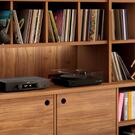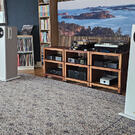Dynaudio has had tremendous success in releasing special versions of both their newer speakers and by giving classic models a thorough upgrade, sometimes even producing them in limited editions. We tested the Contour Legacy at the end of 2024, and the 1,000 pairs produced have reportedly already sold out from the factory. You can still find them at some retailers, but if you want a pair of classic speakers that sound fantastic, you’d better hurry to the store. Fortunately, the Contour 20 Black Edition does not have similar restrictions, which is surely good news for those who take a little longer to make up their minds.
A Big Gap to Fill
It’s not enough to take a well-regarded compact speaker and give both the cabinet and components a nice black finish. Upon closer inspection, it seems that Dynaudio has completely rethought the Contour 20, equipping it with all the tricks, technology, and expertise at their disposal. The result is a speaker that, in many ways, fills the rather wide gap between the Contour 20i and the Confidence 20.
The visible differences from the Contour 20i are not huge, but it has been upgraded in several key areas. First and foremost, it’s black—and very thoroughly so. The fully black, high-gloss cabinets come with black drivers, black front plates for the tweeters, black aluminum plates on the front baffle, and black plates around the rear terminals. They are beautifully made and don’t appear as pitch black as you might think. The different material reflections, particularly on the anodized front plate, contribute to this.
The goal is as difficult as it is simple: create a precise and accurate speaker without compromising its musicality, make it straightforward and understandable, ensure it doesn’t cause listening fatigue even during long sessions, and make it sound authentic, natural, and free of distracting elements. Some may argue that the Contour 20i already meets these criteria, but improvements can always be made.
Outstanding Components
In the pursuit of even better sound, more detail, and improved dynamic capabilities in the treble range, the designers have equipped this model with the highly detailed and precise Esotar3 tweeter. This driver features a powerful neodymium magnet, an aluminum voice coil, a large rear chamber, Dynaudio’s proprietary Hexis technology—which breaks up resonances that form behind the diaphragm—and a DSR-coated fabric diaphragm. According to Dynaudio, this enhances both the dynamics and the tweeter’s ability to reproduce fine details.
The mid/bass driver is a new variant of their existing 18W55 bass unit. Like the tweeter, it also has a neodymium magnet and an MSP (Magnesium Silicate Polymer) diaphragm, improved airflow around the back of the driver, and a fiberglass voice coil former. Again, the goal has been increased precision and dynamics, but the driver has also gained a couple of extra dB in sensitivity. This makes it slightly more efficient and allows it to play audibly louder. However, if you look at the technical specifications, you might not immediately see this improvement. This is due to the bass driver’s increased linearity and how it affects measurements.
Placement
You could write many pages about speaker placement, but in this case, all I had to do was place the speakers on a pair of good stands and position them according to the tape markings on my living room floor, ensuring a distance of about 60cm from the dampened back wall. This setup generally works well for many compact speakers, and the same applies to the Contour 20 BE. I toed them in slightly toward the listening position, which resulted in even better holography and improved focus on individual instruments. I also tried pulling them far out into the room, which worked brilliantly—providing a more solid bass response than expected and, at times, a grandiose soundstage. Imagine having a dedicated music room where the speakers could stand freely in the middle of the floor!
The Sound
How much bass can you really expect from speakers as compact as these? Quite a lot, it turns out. The new bass drivers and large bass ports allow the Contour 20 BE to deliver a surprisingly strong bass response. In fact, to the extent that you no longer feel like you’re missing any bass, even on the most demanding recordings.
When Submotion Orchestra rumbles through Variations, you do notice that a few of the lowest tones are missing, but what comes out of these speakers is tight, well-formed, exceptionally controlled, and very dynamic. You can also push the volume much higher than expected. Even at high—very high—volumes, the dynamics remain excellent, and there are no signs of the speaker losing control or becoming stressed.
The Contour 20 Black Edition is easy to drive and can perform well with a smaller amplifier, but in that case, you might not fully utilize all of its capabilities. It plays so cleanly and precisely that I found myself playing at higher volumes than usual, simply because the speakers encourage it. They don’t give you any reason to turn it down. The speaker’s inherent characteristics do not change at all—it just gets louder and even more fun.
The balance is neutral, well-balanced, and completely natural. The best way to describe the sound might be subtle and calm. It is incredibly relaxed and unforced, and Dynaudio has managed to bring out the inner life of the music without adding extra energy in the presence range or exaggerating the treble or bass.
High-Level Performance

It’s fair to have high expectations for a new pair of speakers from Dynaudio. I remember the Contour Legacy, which was both more and less than the new Contour 20 BE—more bass, deeper extension, but perhaps not quite the same musical insight and precision.
To truly appreciate their musicality, I played Blågutten by Hoff Ensemble. The piano tones and their decay were stunning, and Mathias Eick’s trumpet sounded gorgeous in the soundstage, surrounded by rich reverberation.
Conclusion
Dynaudio has released many successful models in recent years, and I thought they peaked with the Contour Legacy in 2024. But now they have taken another step forward—creating a precise yet highly musical speaker that also delivers a lot of fun, provided you pair it with a suitable amplifier.
It successfully bridges the gap between the Confidence and Contour 20i and proves that compact speakers can indeed compete with smaller floor-standing models in dynamics, punch, and room-filling sound.
Welcome to the dark side!

 Vipps oss en gave: 129702
Vipps oss en gave: 129702




